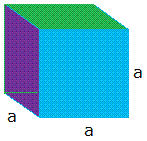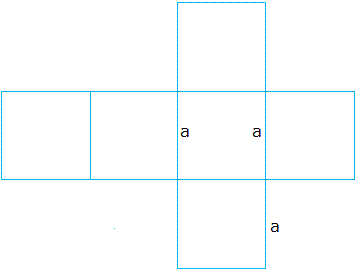Surface area of a cube
To derive the formula of the surface area of a cube, you will need to start with a cube as shown below and call the length of one side a.
In order to make a cube like the one shown above, you basically need to use the following cube template:

Looking at the cube template, it is easy to see that the cube has six sides and each side is a square.
Since the length of an edge is a, the area of one square is a × a = a2
Since there are six sides, the total surface area, call it SA, can be found as shown below:
SA = a2 + a2 + a2 + a2 + a2 + a2
SA = 6 × a2
A few examples showing how to find the surface area of a cube
Example #1:
Find the surface area if the length of one side is 3 cm.
Surface area = 6 × a2
Surface area = 6 × 32
Surface area = 6 × 3 × 3
Surface area = 6 × 9
Surface area = 54 cm2
Example #2:
Find the surface area if the length of one side is 5 cm.
Surface area = 6 × a2
Surface area = 6 × 52
Surface area = 6 × 5 × 5
Surface area = 6 × 25
Surface area = 150 cm2
Example #3:
Find the surface area if the length of one side is 1/2 cm.
Surface area = 6 × a2
Surface area = 6 × (1/2)2
Surface area = 6 × 1/2 × 1/2
Surface area = 6 × 1/4
Surface area = 6/4 cm2
Surface area = 3/2 cm2
Surface area = 1.5 cm2
Example #4:
Find the surface area if the length of one side is 2 1/3 cm.
First, convert 2 1/3 into a proper fraction.
2 1/3 = (2 × 3 + 1) / 3 = (6 + 1)/3 = 7/3
Surface area = 6 × a2
Surface area = 6 × (7/2)2
Surface area = 6 × 7/2 × 7/2
Surface area = 6 × 49/4
Surface area = 294/4 cm2
Surface area = 73.5 cm2